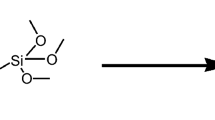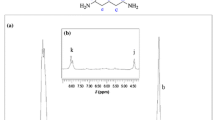Abstract
Enhancing the dispersion stability and self-antibacterial properties of cationic waterborne polyurethane materials is of vital importance to its various applications. In this work, a novel UV-curable waterborne polyurethane with pendant amine (PWPU) from 4-NCO prepolymer and modified by guanidinoacetic acid (GAA) was prepared by a simple method. The 4-NCO prepolymer is originated from the progressively grafting of tridentate polycaprolactone. The GAA, which is rarely used in coating industry, plays a positive reinforced role in our self-antibacterial coatings. Taking fully advantage of the merits of pendant amine and GAA, PWPU without bactericides possesses excellent properties in gram-negative (92.05%) and gram-positive (94.77%) antibacterial tests. Compared with the linear amine waterborne polyurethane (LWPU), PWPU has significant superiority in stability, and the increase in antibacterial efficiency is about 50%. Moreover, antibacterial efficiency still maintained 87.94% after 12 times washing. AFM results display that GAA and pendant amine increase the hydrophilic groups of coating surface, which improves the antibacterial performance. The experiments of thermal, mechanical performance and chemical resistance proof the reliability of the coatings. Therefore, this work has large potential in the applications of antibacterial materials.














Similar content being viewed by others
References
Fuchs AD, Tiller JC (2006) Contact-active antimicrobial coatings derived from aqueous suspensions. Angew Chem Int Ed 45:6759–6762
Kumar M, Bala R, Gondil VS, Pandey SK, Chhibber S, Jain DVS, Sharma RK, Wangoo N (2017) Combating food pathogens using sodium benzoate functionalized silver nanoparticles: synthesis, characterization and antimicrobial evaluation. J Mater Sci. doi:10.1007/s10853-017-1072-z
Wynne JH, Fulmer PA, McCluskey DM, Mackey NM, Buchanan JP (2011) Synthesis and development of a multifunctional self-decontaminating polyurethane coating. ACS Appl Mater Interfaces 3:2005–2011
Xu X, Zheng AN, Zhou XD, Guan Y, Pan YF, Xiao HN (2015) Antimicrobial polyethylene wax emulsion and its application on active paper-based packaging material. J Appl Polym Sci 132(27). doi:10.1002/app.42214
Huang YH, Chen MHC, Lee BH, Hsieh KH, Tu YK, Lin JJ, Chang CH (2014) Evenly distributed thin-film Ag coating on stainless plate by tricomponent Ag/Silicate/PU with antimicrobial and biocompatible properties. ACS Appl Mater Interfaces 6:20324–20333
Timofeeva L, Kleshcheva N (2011) Antimicrobial polymers: mechanism of action, factors of activity, and applications. Appl Microbiol Biotechnol 89:475–492
Siedenbiedel F, Tiller JC (2012) Antimicrobial polymers in solution and on surfaces: overview and functional principles. Polymers 4:46–71
Liu K, Su ZG, Miao SD, Ma GH, Zhang SP (2016) UV-curable enzymatic antibacterial waterborne polyurethane coating. Biochem Eng J 113:107–113
Kugimoto Y, Wakabayashi A, Dobashi T, Ohnishi O, Doi TK, Kurokawa S (2016) Preparation and characterization of composite coatings containing a quaternary ammonium salt as an anti-static agent. Prog Org Coat 92:80–84
Toker RD, Apohan NK, Kahraman MV (2013) UV-curable nano-silver containing polyurethane based organic–inorganic hybrid coatings. Prog Org Coat 76:1243–1250
Li JH, Hong RY, Li MY, Li HZ, Zheng Y, Ding J (2009) Effects of ZnO nanoparticles on the mechanical and antibacterial properties of polyurethane coatings. Prog Org Coat 64:504–509
Tiller JC, Liao CJ, Lewis K, Klibanov AM (2001) Designing surfaces that kill bacteria on contact. Proc Natl Acad Sci USA 98:5981–5985
Garrison TF, Zhang ZY, Kim HJ, Mitra D, Xia Y, Pfister DP, Brehm-Stecher BF, Larock RC, Kessler MR (2014) Thermo-mechanical and antibacterial properties of soybean oil-based cationic polyurethane coatings: effects of amine ratio and degree of crosslinking. Macromol Mater Eng 299:1042–1051
Ho CH, Tobis J, Sprich C, Thomann R, Tiller JC (2004) Nanoseparated polymeric networks with multiple antimicrobial properties. Adv Mater 16:957–961
Liu GF, Wu GM, Jin C, Kong ZW (2015) Preparation and antimicrobial activity of terpene-based polyurethane coatings with carbamate group-containing quaternary ammonium salts. Prog Org Coat 80:150–155
Grapski JA, Cooper SL (2001) Synthesis and characterization of non-leaching biocidal polyurethanes. Biomaterials 22:2239–2246
Wei DF, Ma QX, Guan Y, Hu FZ, Zheng A, Zhang X, Teng Z, Jiang H (2009) Structural characterization and antibacterial activity of oligoguanidine (polyhexamethylene guanidine hydrochloride). Mater Sci Eng C 29:1776–1780
Wender PA, Galliher WC, Goun EA, Jones LR, Pillow TH (2008) The design of guanidinium-rich transporters and their internalization mechanisms. Adv Drug Deliv Rev 60:452–472
Mattheis C, Wang H, Meister C, Agarwal S (2013) Effect of guanidinylation on the properties of poly (2-aminoethylmethacrylate)-based antibacterial materials. Macromol Biosci 13:242–255
Michl TD, Locock KES, Stevens NE, Hayball JD, Vasilev K, Postma A, Qu Y, Traven A, Haeussler M, Meagherb L, Griesserd HJ (2014) RAFT-derived antimicrobial polymethacrylates: elucidating the impact of end-groups on activity and cytotoxicity. Polym Chem 5:5813–5822
Fischer M, Vahdatzadeh M, Konradi RT, Friedrichs J, Maitz MF, Freudenberg U, Werner C (2015) Multilayer hydrogel coatings to combine hemocompatibility and antimicrobial activity. Biomaterials 56:198–205
Qin LL, He Y, Liu BH, Jian Y, Li CG, Nie J (2013) Preparation and properties of polyurethane acrylates modified by saturated alcohols. Prog Org Coat 76:1594–1599
Fang ZH, Duan HY, Zhang ZH, Wang J, Li DQ, Huang YX, Shang JJ, Liu ZY (2011) Novel heat-resistance UV curable waterborne polyurethane coatings modified by Melamine. Appl Surf Sci 257:4765–4768
Pan XJ, Sun DC (2015) Novel cationic UV-curable cathodic electrophoretic coatings with pendant amine salt. J Chem Ind Eng 66:4696–4702
Dilger RN, Angeloni KB, Payne RL, Lemme A, Parsons CM (2013) Dietary guanidino acetic acid is an efficacious replacement for arginine for young chicks. Poult Sci 12:171–177
Chaudhari AB, Tatiya PD, Hedaoo RK, Kulkarni RD, Gite VV (2013) Polyurethane prepared from neem oil polyesteramides for self-healing anticorrosive coatings. Ind Eng Chem Res 52:10189–10197
Llorente O, Fernández-Berridi MJ, González A, Irusta L (2016) Study of the crosslinking process of waterborne UV curable polyurethane acrylates. Prog Org Coat 99:437–442
Xu JC, Rong XS, Chi TY, Wang M, Wang YY, Yang DY, Qiu FX (2013) Preparation, characterization of UV-curable waterborne polyurethane acrylate and the application in metal iron surface protection. J Appl Polym Sci 130:3142–3152
Madbouly SA, Otaigbe JU, Nanda AK, Wicks DA (2005) Rheological behavior of aqueous polyurethane dispersions: effects of solid content, degree of neutralization, chain extension, and temperature. Macromolecules 38:4014–4023
Lu ZQ, Zhu YY, Lin JB, Jiang XK, Li ZT (2010) Hydrogen bonded foldamer-bridged biscoumarins: a UV-Vis absorption and fluorescent study of the solvent effect. Chin Sci Bull 55:2870–2878
López-García JJ, Grosse C, Horno J (2009) On the use of the Stern-layer and the charged-layer formalisms for the interpretation of dielectric and electrokinetic properties of colloidal suspensions. J Colloid Interface Sci 329:384–389
Liu K, Miao SD, Su ZG, Sun LJ, Ma GH, Zhang SP (2016) Castor oil-based waterborne polyurethanes with tunable properties and excellent biocompatibility. Eur J Lipid Sci Technol 118:1512–1520
Zhang T, Wu WJ, Wang XJ, Mu YP (2010) Effect of average functionality on properties of UV-curable waterborne polyurethane-acrylate. Prog Org Coat 68:201–207
Acknowledgements
The authors would like to thank the financial support from the Major Science and Technology Projects of Hunan Province, China (2015GK1004). Thanks to Prof. Shengpei Su of Hunan Normal University for his warm help and guidance.
Author information
Authors and Affiliations
Corresponding author
Ethics declarations
Conflict of interest
The authors declare that we have no conflict of interest.
Electronic supplementary material
Below is the link to the electronic supplementary material.
Rights and permissions
About this article
Cite this article
Du, S., Wang, Y., Zhang, C. et al. Self-antibacterial UV-curable waterborne polyurethane with pendant amine and modified by guanidinoacetic acid. J Mater Sci 53, 215–229 (2018). https://doi.org/10.1007/s10853-017-1527-2
Received:
Accepted:
Published:
Issue Date:
DOI: https://doi.org/10.1007/s10853-017-1527-2




